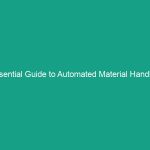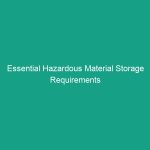Good morning team!
Today, we’re going to discuss a crucial topic that affects our Safety and well-being at work: Essential Combustible Dust Explosion Prevention: Housekeeping & Ventilation Tips. Understanding how to manage combustible dust is vital, not just for compliance, but for ensuring a safe working Environment for all of us.
Combustible dust can pose serious Hazards if not properly managed. By the end of this Toolbox Talk, you will know how to identify risks and implement Best Practices to prevent dust explosions effectively.
Understanding Essential Combustible Dust Explosion Prevention
Combustible dust refers to fine particles that can ignite and explode when suspended in the air and exposed to an ignition source. Common materials that create combustible dust include wood, metal, plastics, and food products.
Why is this important? Every day, we handle materials that can create dust. If this dust accumulates and is not adequately managed, it can lead to catastrophic explosions, endangering lives and property. A common misconception is that dust is only a nuisance; however, it can have serious consequences if left unchecked.
Key Hazards, Risks, and Safety Considerations
Combustible dust presents several hazards that we must be aware of:
- Accumulation: Dust buildup can lead to a significant risk of explosion. Even small amounts of dust can create a hazardous environment.
- Ignition Sources: Common ignition sources include sparks from machinery, static electricity, and open flames.
- Poor Ventilation: Inadequate airflow can contribute to dust accumulation and increase explosion risk.
Ignoring these hazards can lead to severe consequences, including injuries, loss of life, and significant damage to facilities. It’s crucial that we all remain vigilant about our environment.
Best Practices, Procedures, & Actionable Advice
To prevent combustible dust explosions, we need to implement effective housekeeping and ventilation practices:
Housekeeping Tips
Good housekeeping is the first line of defense against combustible dust hazards:
- Regular Cleaning: Establish a routine for cleaning areas where dust accumulates, such as floors, machinery, and surfaces.
- Use Proper Equipment: Utilize industrial vacuums designed for combustible dust instead of brooms. This prevents dust from becoming airborne.
- Control Dust at the Source: Implement measures such as wetting down materials or using dust suppression systems during operations.
Ventilation Tips
Proper ventilation is essential for minimizing dust hazards:
- Maintain Airflow: Ensure that ventilation systems are functioning properly to keep air moving and dilute dust concentrations.
- Use Local Exhaust Ventilation: Install exhaust systems at dust-generating points to capture and remove dust directly from the source.
- Regular Maintenance: Inspect and maintain ventilation systems regularly to keep them effective and compliant with safety Standards.
Real-Life Examples
Consider the incident at a food processing plant where insufficient housekeeping led to a tragic explosion. Dust had accumulated over time, and a small spark ignited it, resulting in extensive damage and injuries. This incident reinforces the importance of maintaining clean and well-ventilated work areas.
Regulations, Standards, and Compliance
Compliance with safety Regulations is crucial for protecting everyone:
- OSHA Standards: The Occupational Safety and Health Administration (osha) provides regulations for managing combustible dust hazards.
- NFPA Guidelines: The National Fire Protection Association (NFPA) has established guidelines outlining prevention measures for combustible dust.
Following these standards not only helps prevent accidents but also ensures that we are legally compliant, which is vital for our organization and personal safety.
Employee Engagement & Discussion
Now, I’d like to hear from you. What safety challenges have you encountered related to combustible dust? Are there any practices you recommend that have worked well in your experience?
Your input is essential. Engaging in discussions about safety can lead to better practices and a safer workplace for everyone.
Conclusion & Key Takeaways
In summary, managing combustible dust is critical for our safety. Here are the key points we discussed:
- Understand the risks associated with combustible dust.
- Implement effective housekeeping and ventilation strategies.
- Comply with established safety regulations to protect yourself and your coworkers.
Let’s prioritize safety and ensure we apply these practices daily. Thank you all for your attention and commitment to maintaining a safe work environment. Remember, safety is everyone’s responsibility!


